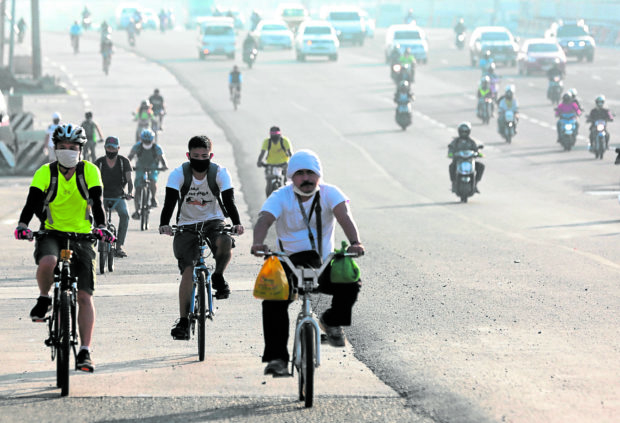Pandemic shows why Metro Manila needs more, better bike lanes

NEED FOR RELIABLE STATS The bike count project was launched to fill data gaps on active transport and complement the manual bike count conducted by local governments. —GRIG C. MONTEGRANDE
With around half a million people now biking to work in Metro Manila due to the coronavirus pandemic, the government should put up better road infrastructure that moves people and not cars, according to a group advocating environment-friendly modes of transportation and who monitored bicycle use in the capital in June.
Aldrin Pelicano, founder of MNL Moves, said a spike in the number of bikers was noted in the project that analyzed traffic flow and movement trends at 32 locations in the cities of San Juan, Pasig, Quezon City and Marikina.
Based on manual count conducted on June 8 alone, particularly during peak hours from 6 a.m. to 8 a.m. and from 4 p.m. to 6 p.m., at least 38,932 cyclists, 12,787 pedestrians and 1,658 nonmotorized travelers (those on skateboards, pedicabs, scooters and wheelchairs) used the roads.
Among the cyclists, about 54 percent were recorded in the morning rush hour.
Filling data gaps
The cyclists occupied 105.12 square kilometers of road space, which can mobilize only 6,256 people in cars, according to their field survey.
The bike count project was launched to fill data gaps on active transport and complement the manual bike count conducted by local governments. It was deemed necessary since the national government still lacked reliable statistics on the number of cyclists in the metropolis.
According to MNL Move’s estimate, around half a million people now cycle to work in Metro Manila.
However, Pelicano said this number was still a “significant undercount,” as he urged the Metro Manila Development Authority (MMDA) to make it among its considerations when coming up with new traffic schemes.
“When they count and get the numbers, they can easily justify further investments [in active transport],” Pelicano said, also the inclusive mobility advisor of the Institute for Climate and Sustainable Cities.
Last year, he said, MNL Move asked the MMDA to count bike users passing through Edsa, the country’s busiest thoroughfare. The agency was later able to log a total of more than 100,000 cyclists on Edsa in June 2020.
Local observations
“This is really consistent to the observed rise in the number of cyclists in different parts of Metro Manila, so people who choose to walk and cycle deserve much better pedestrian and cycling facilities and infrastructure,” he said.
Officials in Pasig and Quezon City agreed that local bicycle traffic had increased.
Robert Anthony Siy III, head of the Pasig City Transport Office, said there were certain days when bicycles outnumbered private cars.
On Amang Rodriguez Avenue on May 6, for example, 1,121 cyclists used the road during peak hours, compared to 943 motorists.
“When you have numbers like this, we should already be [creating] wider bike lanes,” Siy said. “It’s about time we started thinking about the needs of people who want to use [transport] modes other than cars. If you build bike lanes, sidewalks, and high-quality public transportation, Filipinos will surely support these initiatives if you give them the right service and the right facilities.”
In Quezon City, Mayor Joy Belmonte said around 200,000 cyclists use city roads daily. The local government, she said, has designated 93 kilometers of interconnected and protected bike lanes.
She recalled that when the pandemic started, the city government had to address three key issues: car-centric roads, the lack of public transport and the need for responsive transport management.
Supporting active transport modes, such as cycling and walking had been the city government’s priority, she said.
“Our metropolis, especially our city, is a very car-centric society. For me, that’s very misguided, considering that the majority of our people do not have cars,’’ the mayor added.